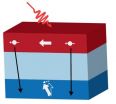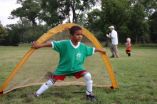(Press-News.org) SEATTLE, WA – As cases of Little League Shoulder (LLS) occur more frequently, the need for additional information about the causes and outcomes of the condition has become clear. Researchers presenting at the American Orthopaedic Society for Sports Medicine's (AOSSM) Annual Meeting today shared new data identifying associated risk factors, common treatment options and return to play.
"Our study examined 95 patients ranging from 8-17 years old diagnosed with Little League Shoulder," commented Benton E. Heyworth, MD, corresponding author from Children's Hospital Boston, Division of Sports Medicine in Boston, Massachusetts. "Not surprisingly, we found 97% of the affected athletes were baseball players, with 50% of the patients being only 12 or 13 years old – a good indicator of the stress being put on young arms."
Of the 95 patients, 30% were identified with a reduced range of motion during physical exam. These patients were three times more likely to experience an injury recurrence 6-12 months after returning to play.
"The data showed 13% of patients treated also reported elbow pain, 10% reported shoulder pain or weakness, and 8% reported other mechanical symptoms," Heyworth noted. "These related symptoms should be recognized as possible identifiers for injured athletes in the future."
The study examined cases of Little League Shoulder from a single pediatric referral center between 1999 and 2013. Researchers analyzed age, sex, physical examination and radiologic findings, treatment approaches and rates of occurrence.
Treatment options for players included rest in 98% of cases, physical therapy in 79%, and a position change in 25% after returning to play. Average time for returning to play was 4.2 months from injury diagnosis.
INFORMATION:
The American Orthopaedic Society for Sports Medicine (AOSSM) is a world leader in sports medicine education, research, communication and fellowship, and includes national and international orthopaedic sports medicine leaders. The Society works closely with many other sports medicine specialists, including athletic trainers, physical therapists, family physicians, and others to improve the identification, prevention, treatment, and rehabilitation of sports injuries. AOSSM is also a founding partner of the STOP Sports Injuries campaign to prevent overuse and traumatic injuries in kids. For more information on AOSSM or the STOP Sports Injuries campaign, visit http://www.sportsmed.org or http://www.stopsportsinjuries.org
New research identifies risk factors for little league shoulder
Limited range of motion may predict future injury
2014-07-10
ELSE PRESS RELEASES FROM THIS DATE:
Entering MLB early may increase elbow surgery risk
2014-07-10
SEATTLE, WA – The common elbow surgery made famous by Major League Baseball (MLB) pitcher, Tommy John, definitely does its job to return pitchers to the mound, but risks for having the surgery may be able to be recognized earlier in a player's career, say researchers presenting their work at the American Orthopaedic Society for Sports Medicine's (AOSSM) Annual Meeting today. The study was the largest cohort of MLB pitchers, to date, that have undergone UCL reconstruction.
"Our results suggest that UCL reconstructive surgery does a tremendous job in allowing players to ...
Young athletes should consider the benefits of ACL surgery
2014-07-10
SEATTLE, WA – Young patients who wait for ACL surgery may be at increased risk for secondary knee injuries, according to research presented today at the American Orthopaedic Society for Sports Medicine's (AOSSM) Annual Meeting. The study adds to existing research noting the risk of secondary meniscal and chondral injuries in pediatric patients.
"In reviewing records of young patients who received ACL reconstructions, our data showed higher rates and severity of secondary meniscus injuries when surgery is delayed," noted lead author Allen F. Anderson, MD, from the Tennessee ...
Intercollegiate contact athletes with shoulder instability return to in-season sports
2014-07-10
SEATTLE, WA – College athletes experiencing in-season shoulder instability regularly return to play within one week of injury, but developed recurrent instability in 63% of cases, according to research presented today at the American Orthopaedic Society for Sports Medicine's (AOSSM) Annual Meeting. This latest information may help guide team physicians in providing the most optimal treatment plans for injured players.
"We examined 45 athletes who suffered an anterior shoulder instability event, and found that 33 (73%) returned to play for at least part of the season after ...
Stabilizing shoulder surgery helps NFL players return to the game
2014-07-10
SEATTLE, WA – Shoulder instability is a common injury in football players but the rate of return to play has not been regularly determined following surgery. A new study, discussed at the American Orthopaedic Society for Sports Medicine's (AOSSM) Annual Meeting today details that return rates for NFL players is approximately 90 percent no matter what the stabilization procedure (open vs. arthroscopic).
"Our study highlighted the success rate of return to play following shoulder stabilization surgery. Age, number of games before surgery, and career length were not statistically ...
University of Illinois study advances limits for ultrafast nano-devices
2014-07-10
A recent study by researchers at the University of Illinois at Urbana-Champaign provides new insights on the physical mechanisms governing the interplay of spin and heat at the nanoscale, and addresses the fundamental limits of ultrafast spintronic devices for data storage and information processing.
"Electrons carry a charge as well as spin-angular momentum. In a typical charge current, electrons' spin-angular-momentum is random so there is no spin current," explained David Cahill, a professor of materials science and engineering at Illinois. "However when electrons ...
Speeding up data storage by a thousand times with 'spin current'
2014-07-10
A hard drive stores bits in the form of tiny magnetic domains. The directions of the magnetic north and south poles of these domains, which are referred to as the magnetization, determine whether they are a 0 or a 1. Data is stored by changing the direction of the magnetization of the associated bits. At present this is done using a write head to create a local magnetic field, which makes a bit change direction.
Limit reached
The stronger the local magnetic field, the faster the switch takes place. But this is subject to a limit which has now almost been reached. "The ...
Being a good sport ranks as the top 'fun' factor in study of youth sports
2014-07-10
WASHINGTON, DC (July 10, 2014) — If you think winning is one of the key determinants that makes organized sports fun for kids think again: Winning along with other mental bonuses ranked near the bottom of 81 determinants of fun, each of which falls into one of 11 big fun factors, according to a new study. Despite the common belief that winning is all important when it comes to the "fun" factor, very little research had been done to actually identify and quantify what goes into this elusive concept—until now.
The results of this study might help researchers develop proven ...
Go play outside! Outdoor time promotes physical activity in youth
2014-07-10
Cincinnati, OH, July 10, 2014 -- The World Health Organization recommends that youth participate in a minimum of 60 minutes of moderate to vigorous physical activity (MVPA) each day. Studies have shown that youth experience most of their MVPA during school hours. Therefore, it stands to reason that increasing outdoor time after school hours would increase MVPA. In a new study scheduled for publication in The Journal of Pediatrics, researchers confirmed that time spent outdoors after school was positively associated with MVPA.
Drs. Lee Schaefer and Jonathan McGavock, ...
Low back pain? Don't blame the weather
2014-07-10
Australian researchers reveal that sudden, acute episodes of low back pain are not linked to weather conditions such as temperature, humidity, air pressure, wind direction and precipitation. Findings published in Arthritis Care & Research, a journal of the American College of Rheumatology (ACR), indicate that the risk of low back pain slightly increases with higher wind speed or wind gusts, but was not clinically significant.
According to the World Health Organization (WHO) nearly everyone experiences low back pain at some point in their life, making it the most prevalent ...
New class of anti-arthritis drugs effectively treats multiple inflammatory diseases
2014-07-10
Philadelphia, PA, July 10, 2014 – Inflammatory diseases can occur simultaneously in distinct sites in the same patient, complicating treatment because a medication effective for one disorder may exacerbate the other. One such example is the anti-arthritic medication dexamethasone, which alleviates joint disease but can worsen periodontal bone disease. A study in the August issue of The American Journal of Pathology highlights the effects of a new class of anti-arthritic drugs, specifically DTrp8-ɣMSH (DTrp), that acts via the melanocortin (MC) system to reduce both ...
LAST 30 PRESS RELEASES:
New study overturns long-held model of how plants coordinate immune responses.
New AI model predicts disease risk while you sleep
Scientists discover molecular ‘reshuffle’ and crack an 80-year-old conundrum
How stressors during pregnancy impact the developing fetal brain
Electrons lag behind the nucleus
From fungi to brain cells: one scientist's winding path reveals how epigenomics shapes neural destiny
Schizophrenia and osteoporosis share 195 genetic loci, highlighting unexpected biological bridges between brain and bone
Schizophrenia-linked genetic variant renders key brain receptor completely unresponsive to both natural and therapeutic compounds
Innovative review reveals overlooked complexity in cellular energy sensor's dual roles in Alzheimer's disease
Autism research reframed: Why heterogeneity is the data, not the noise
Brazil's genetic treasure trove: supercentenarians reveal secrets of extreme human longevity
The (metabolic) cost of life
CFRI special issue call for papers: New Frontiers in Sustainable Finance
HKU Engineering scholar demonstrates the smallest all-printed infrared photodetectors to date
Precision empowerment for brain "eavesdropping": CAS team develops triple-electrode integrated functional electrode for simultaneous monitoring of neural signals and chemical transmitters during sleep
Single-capillary endothelial dysfunction resolved by optoacoustic mesoscopy
HKU three research projects named among ‘Top 10 Innovation & Technology News in Hong Kong 2025’ showcasing excellence in research and technology transfer
NLRSeek: A reannotation-based pipeline for mining missing NLR genes in sequenced genomes
A strand and whole genome duplication–aware collinear gene identification tool
Light storage in light cages: A revolutionary approach to on-chip quantum memories
Point spread function decoupling in computational fluorescence microscopy
BacPhase: Long-insert paired-end sequencing for bin marker construction and genome phasing
GmWOX1 regulates the mediolateral polarity of compound leaves in soybean
ChargeFabrica: An open-source simulation tool that aims to accelerate search for high performance perovskite solar cells
High levels of ADAR overexpression induce abundant and stochastic off-target RNA editing in rice protoplasts
On-demand upgraded recycling of polyethylene and construction of sustainable multifunctional materials based on the "LEGO" strategy
New "Stomata in-sight" system allows scientists to watch plants breathe in real-time
Anorexia nervosa may result in long-term skeletal muscle impairment
Narrative-based performance reviews deemed fairest by employees
New insights reveal how advanced oxidation can tackle emerging water pollutants
[Press-News.org] New research identifies risk factors for little league shoulderLimited range of motion may predict future injury



